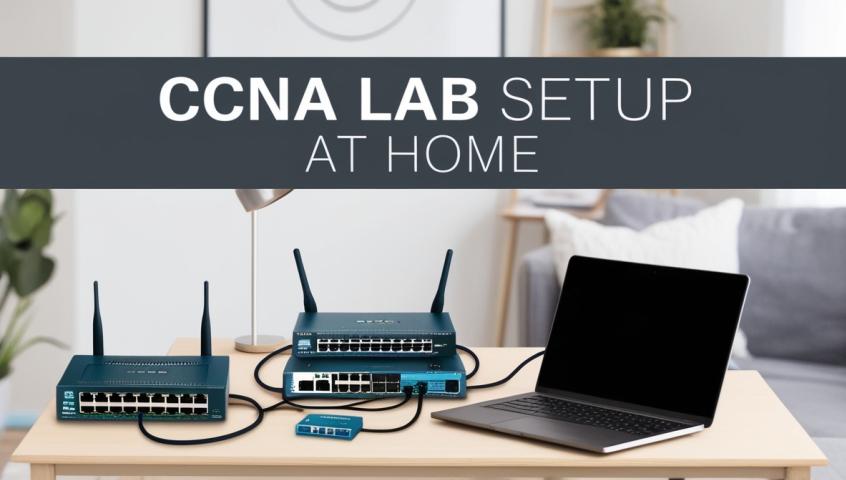as CCNA student, gaining hands-on experience through practical lab exercises is essential for mastering networking concepts and preparing for real-world scenarios. Cisco router setup is a fundamental aspect of the CCNA course, and this guide offers a step-by-step tutorial on how to configure routers effectively. Whether you’re new to networking or brushing up your skills, these exercises will help reinforce your learning and provide valuable insights for your CCNA certification training.
Why Setting Up a Cisco Router Lab Is Important
Having your own Cisco lab environment enables you to practice configuring and managing network devices without the pressure of real-time environments. These hands-on exercises ensure that you’re fully prepared for the CCNA exam, while also equipping you with practical skills that are crucial in a networking career.
Equipment You’ll Need
Before starting your lab exercises, make sure you have the following equipment or simulators:
Cisco routers or network simulation software
Ethernet cables and switches
A computer with terminal software for managing the router's configuration
Step-by-Step Lab Exercises for CCNA
1. Basic Router Configuration
Start with configuring essential settings such as the router’s hostname, password, and interfaces. These configurations form the foundation for all further network setup tasks. Setting a proper hostname makes device identification easier, while passwords help secure access to the router’s management interface.
You’ll also configure the interfaces by assigning IP addresses and activating the interface. This ensures that the router can communicate with other devices in the network.
2. Configuring Static Routing
Static routing is one of the most basic forms of routing, where routes are manually entered into the router’s configuration. This is a great starting point for beginners in the CCNA course, as it introduces core routing concepts and shows how routers determine packet paths based on predefined instructions.
In your lab, set up two routers connected via Ethernet interfaces. Assign IP addresses to each router and configure static routes to ensure that both routers can communicate. This is useful for small, simple networks but also forms the foundation for more complex routing exercises later.
3. Dynamic Routing with RIP
After mastering static routing, the next step is learning dynamic routing protocols like RIP (Routing Information Protocol). RIP automatically updates the routing table based on the network topology and communicates changes with neighboring routers.
In this lab, configure RIP on each router in your network and verify that routing information is exchanged dynamically. This exercise helps you understand how dynamic protocols simplify network management by adapting to topology changes without manual intervention.
4. Configuring VLANs
Virtual Local Area Networks (VLANs) are used to segment network traffic, allowing you to logically separate devices within the same physical network. Setting up VLANs on Cisco switches involves configuring switch ports and assigning them to specific VLANs.
In your lab, create multiple VLANs and assign specific switch ports to each one. You’ll also set up Inter-VLAN routing to allow communication between VLANs via a router, which is a key skill for the CCNA certification.
5. Access Control Lists (ACLs)
ACLs are a critical component of network security, enabling routers to filter traffic based on a set of rules. This lab exercise involves creating ACLs to allow or deny specific types of traffic based on parameters like IP addresses or protocols.
Practice setting up both standard and extended ACLs on your routers. Use ACLs to control which devices or types of traffic are permitted to pass through the router’s interfaces. This exercise demonstrates the importance of network security and traffic management, which are central to the CCNA certification.
6. Network Address Translation (NAT)
NAT is used to translate private IP addresses within a local network into a public IP address when communicating with external networks. This is a vital skill for CCNA students, as NAT is widely used in enterprise networks to manage IP address allocations efficiently.
In your lab, configure NAT on a router to enable devices with private IP addresses to communicate with external networks. Experiment with different types of NAT configurations, such as static, dynamic, and PAT (Port Address Translation), to understand their applications in real-world scenarios.
7. Configuring DHCP
Dynamic Host Configuration Protocol (DHCP) automates the process of assigning IP addresses to devices in a network. In this lab exercise, set up a DHCP server on your Cisco router to dynamically assign IP addresses to connected devices.
This exercise is particularly useful in larger networks, where manual IP address assignment would be inefficient. You’ll also practice configuring DHCP exclusions and reservations to fine-tune the IP address management in your lab environment.
8. Troubleshooting with Ping and Traceroute
No network setup is complete without the ability to troubleshoot connectivity issues. Use tools like Ping and Traceroute to test and diagnose communication between devices in your lab.
These basic troubleshooting techniques allow you to identify and fix network issues related to IP configuration, routing, and network reachability. As you practice, you’ll become proficient in detecting and resolving common network problems, a critical skill for any CCNA-certified professional.
Conclusion
Setting up a lab environment to practice essential router configurations is one of the most effective ways to prepare for the CCNA exam and boost your networking skills. These exercises cover the fundamental concepts and techniques that you will encounter in real-world networking environments, from configuring basic settings to implementing dynamic routing protocols, VLANs, and security measures like ACLs and NAT. By investing time in practical labs, you can ensure success in your CCNA certification training and build a strong foundation for your career in networking.





